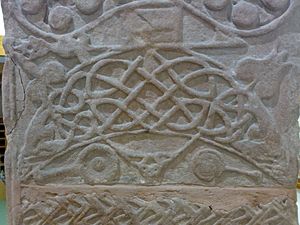Rosemarkie Stone facts for kids
The Rosemarkie Stone is a very old and important stone made by the Picts. It is also called the Rosemarkie Cross. This stone is a great example of the amazing art the Picts created a long, long time ago. It is known as a Class II Pictish stone because it has both a Christian cross and older Pictish symbols carved on it.
Contents
What is the Rosemarkie Stone?
The Rosemarkie Stone is a large stone carved from a type of rock called fine-grained sandstone. It was found a long time ago, before the year 1821, inside an old church in the village of Rosemarkie. This village is on the Black Isle in a part of Scotland called Easter Ross. Rosemarkie was probably a very important place for the Picts, maybe even having a large monastery there. A monastery is a place where monks live and work.
How Was the Stone Found?
When the stone was first discovered, it was broken into two pieces. Imagine finding a giant puzzle piece! Luckily, these two parts have been put back together. Now, you can see the whole stone on display at the Groam House Museum in Rosemarkie. It's like a treasure from the past that you can visit today.
What Can You See on the Stone?
The Rosemarkie Stone is covered in cool carvings on all sides.
The Front Side: A Beautiful Cross
On the front of the stone, there is a fancy cross. It's not just a simple cross; it's decorated with many detailed patterns. These patterns are called "interlace patterns," which look like ribbons weaving over and under each other.
The Back Side: Mysterious Pictish Symbols
The back of the stone is even more interesting because it has many common Pictish symbols. The Picts were an ancient people who lived in Scotland. They used these symbols to mean different things, but we don't always know exactly what they meant!
- Three Crescents and V-Rods: You can see three symbols that look like a crescent moon with a V-shape attached. This is very special because the Rosemarkie Stone is the only Pictish stone known to have the same symbol repeated three times!
- Double-Disc and Z-Rod: There's also a symbol that looks like two circles joined together, with a Z-shape going through them.
- A Smaller Cross: At the very bottom of the back side, there is another, smaller cross.
Decorated Sides
Even the narrow sides of the stone are decorated! They also have those cool interlace patterns that weave and twist, showing how skilled the Pictish artists were.
The Rosemarkie Stone is a fantastic window into the world of the Picts and their amazing art. It helps us learn more about their culture and beliefs.



